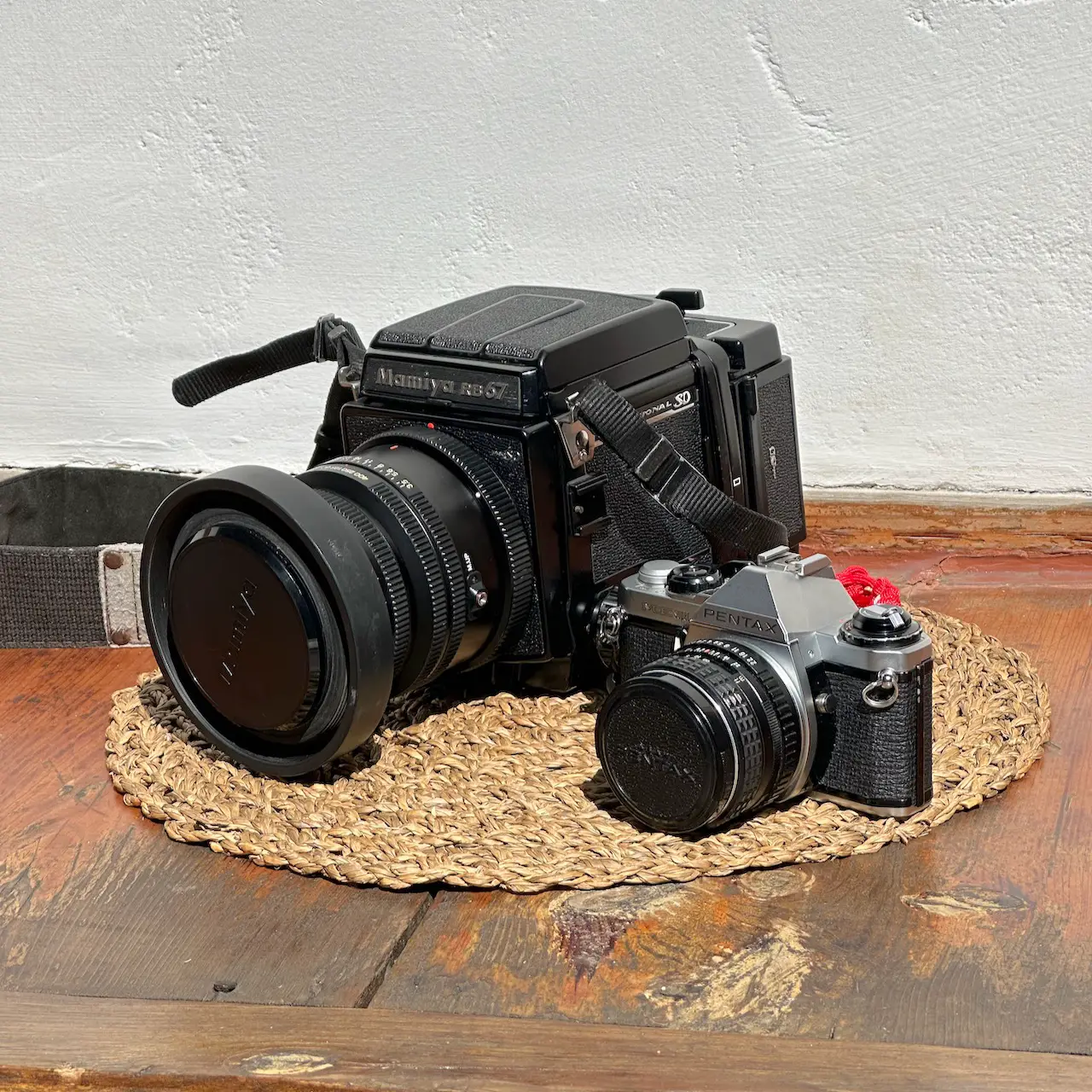5 frames of Shanghai GP3 100 in a Mamiya RB67
Bargain hunting for a Mamiya RB67 in Seoul turned out to be a bigger adventure, and a lot more fun, than I'd anticipated

[Originally published on 35mmc.]
When on vacation, one of my favorite activities is hitting the second hand markets for good deals on used camera gear. And, if you've never been, Namdaemun Market in Seoul does not disappoint. Home to several dozen used camera dealers ranging from large, well-appointed stores to tiny counters buried in the basement of packed market halls, the dealers in Namdaemun have nearly anything you could want at surprisingly reasonable prices.

On this, my first trip to Seoul, I had a particular target: I was hunting for a Mamiya RB67. All told, I must have looked at dozens of them, in various states, all priced seemingly at random. In the end, I found a dealer who had two RB67 Pro SDs each with parts in better or worse states. (If you aren't familiar, the RB67 breaks down into six or so modular parts: the lens, body, focusing screen, viewfinder, rotating back, and film back.) As part of the negotiation, I requested to build a camera using the best parts from both. I walked away with a complete camera in excellent condition at a price well under my budget.

The more reputable (though not necessarily more expensive) dealers guarantee their ware: Once the deal was complete, I was told I could bring it back if there was any problem, and they'd resolve it for me. Which meant I needed to put a roll through the camera quickly. Unfortunately they didn't sell film. I had to hunt quite a bit before I found another store that did. (The irony! Surrounded by gorgeous film cameras of every make and model…but not a lick of film!) I asked for a roll of their cheapest 120 film, and was handed something I'd never encountered before: Shanghai GP3 100. A quick internet search was not encouraging: It seems to be either rebranded Orwo (well, ok!) or some absolute dodgy shit. Frankly, I didn't care: I needed a tool to establish that there were no obvious light leaks or problems with the shutter, so I bought a roll.

I immediately returned to our lodgings in Bukchon Hanok Village, an ancient and historical neighborhood near the old imperial palaces. And here, I lugged the massive and heavy RB67 all through this beautiful neighborhood, filled with beautifully dressed people, running the shutter through its paces.
This is a good point to interject something I only recently learned about Korea, but which you may already know: Koreans are enormously proud of their cultural heritage, and are very eager to share it. The preserved hanok villages are a big part of this, and I strongly recommend staying at a traditional house if you have the chance. Something that might surprise is that many of the cultural sites in central Seoul are free to visit if you are wearing traditional garb—the hanbok. There are hundreds of stores that will rent you hanboks for the day inexpensively. And the feeling of walking through ancient palaces surrounded by people wearing hanboks is frankly incredible. It really feels like you've stepped back in time. Though it may sound like a silly thing, if you ever visit Seoul, I really recommend renting a hanbok and touring the palaces. Anyway, this will explain the dress in the photographs attached to this story!

Getting the film developed (and scanned) was the last piece of the puzzle. This turned out to be less of a problem than I'd expected. If you ever need film developed in Seoul, I cannot recommend Film 135/36 strongly enough. They were professional, courteous, reasonably priced, and turned the film around in about 48 hours. When I picked up the film, I had a chance to chat with the owner about the film itself. He had personally handled the scans, and was impressed by the quality of the images produced. As was I.
Although the grain is surprisingly pronounced for a 6x7 format image, the tonality, sharpness, and dynamic range are worth calling out. You'll notice that, despite the sunny day producing high-contrast lighting, the shadows are never blocked up. All in all, I would happily shoot Shanghai GP3 100 again, although I have no idea where to get it in Europe.

Anyway, as you can see, the camera checked out, and I had no need to return it for servicing.
What are the takeaways? Seoul is a great place to find deals on used film cameras—far better than Tokyo, though that's a topic for a future article. Seoul is also a very film-friendly place, with sources for fresh film (though you do have to hunt) and development that won't break the bank. And, finally, if you have the chance to purchase Shanghai GP3 100, do not hesitate—the cheap price and excellent dynamic range make it an easy buy.
Addendum
Here is an abbreviated list of retailers that might be helpful!
- I bought my camera at 신태양시 (Sintaeyangsi). (Location)
- The Shanghai GP3 100 is from 당근CAMERA (Carrot Camera) just down the street. (Location)
- I got the film developed at 135/36. (Location)
- The owner of 135/36 pointed me to 세기P&C (Segi P&C), which has all the Ilford and Kodak film, good prices. (Location)